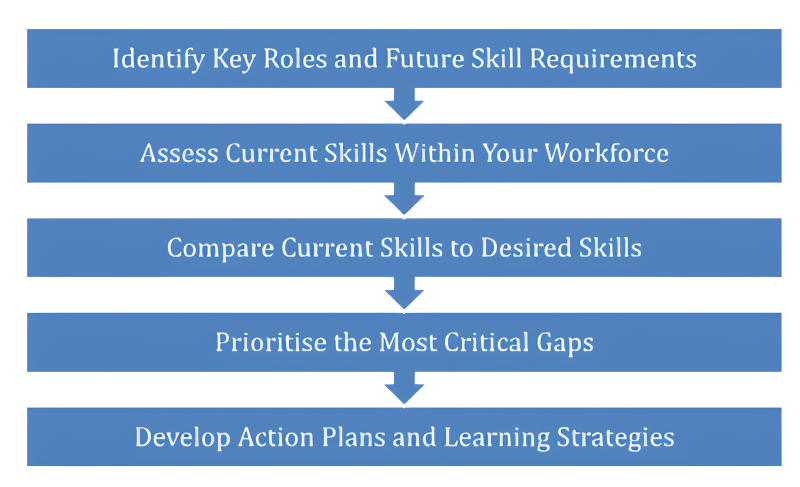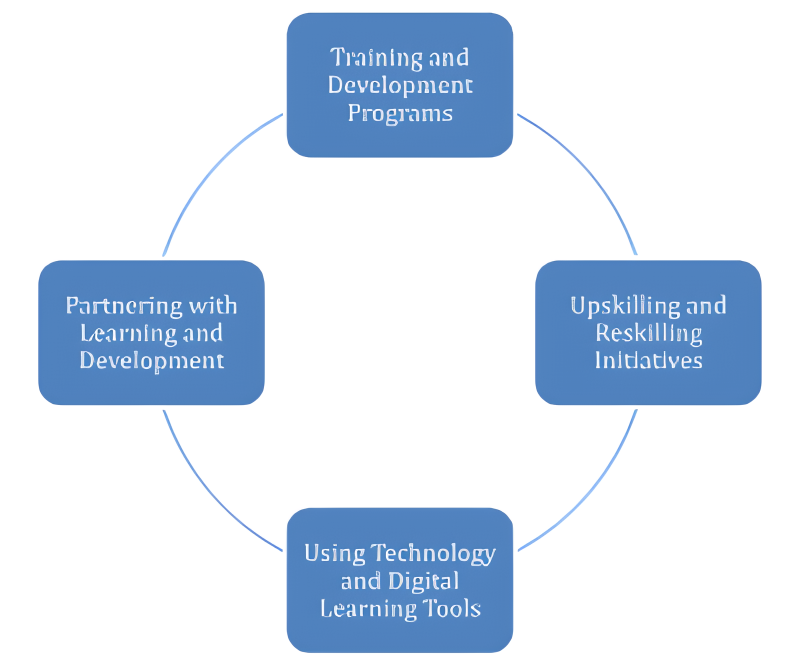As a business owner, CEO, or manager, you need to learn to assess employees’ actual skills and knowledge, as well as practically understand how to develop your workforce to create a more effective team. This is where skills gap analysis comes into play.

If you are looking to create an effective workforce for your business that will be a solid foundation to meet your business objectives, this practical guide can help. It will discuss what skills gap analysis is and how it is applicable.
What Is a Skills Gap?
By the formal definition, skills gap can be stated as a discrepancy that occurs between the skills required by a certain business and the skills that the business’s employees and recruits have. As per a 2024 study by the Business Outlook, 77% of UK business leaders believe a gap in skills is affecting their business’s productivity.
Thus, the skills gap has become a significant obstacle that is harming the productivity of workforces and the overall growth of businesses.
Here is a look into some deeper contexts for the skills gap in organisations:
Why Understanding Skill Gaps Matters for Business Growth
There are different underlying impacts that a workforce with a skills gap has on the growth of a business. Not only is an underskilled workforce less than appropriately productive, but it also leads to a reduction in work quality and overall output, leading to businesses being unable to meet customer needs.
In fact, 53% of business leaders in the UK say that productivity issues developed from the skills gap are harming their business’s growth. Therefore, it has become imperative for industry leaders to understand what is skills gap in order to improve a business’s ability to develop.
Common Causes of Skills Gaps in the Workplace
The presence of a gap in the workplace competencies can be attributed to many causes. However, the main cause of it has been the continued changes in job roles. This has been reflected in a 2021 Gartner research, which states that 58% of the UK workforce needs new skills to suit modern job requirements.
Thus, business leaders identify some of the common causes of workplace skill gaps as:
- Technology becoming integrated into all industry services, and being an ever-changing landscape.
- The implementation of emerging automation techniques, such as robotics and artificial intelligence.
- A need for more specialized and tailored services across industries.
These observed causes can be attributed to the consistently evolving modern job requirements, leading to an increased prevalence of skills gaps.
What is a Skills Gap Analysis?
As companies all over the world struggle to find the correct people to fill key job roles, it has become an increasing need in business leadership and management to identify how to close skills gaps.
Now, what is a skills gap analysis? It can be referred to as a tool that evaluates the difference between a workforce’s present competencies with what the business needs. Thus, it helps businesses identify what skills the workforce actually needs.
Skills Gap vs. Skills Gap Analysis: What’s the Difference?
While skills gap and skills gap analysis sound like very similar terms, it is the “analysis” that brings the difference between the two concepts into the spotlight. Thus, to explore the difference, here is a chart:
| Factors | Skills Gap | Skills Gap Analysis |
| Concept | It is the divergence between the skills required in a business and the skills possessed by employees. | It is a tool used to measure the skills gap in a business’s workforce. |
| Consequence | Reduced productivity and the inability to meet a business’s goals. | Identified skills gaps, future needs, and developed a plan for workforce development. |
| Purpose | To identify if the workforce skill level is on par with what the business needs. | To bridge the skills gap in the workforce. |
| Process | It is just the concept; no processes are considered. | The process involves assessing existing workforce skills and identifying required skills for comparison. |
Table: Skills Gap vs. Skills Gap Analysis
Benefits of Conducting a Skills Gap Analysis
The primary benefit of conducting a skills gap analysis is helping business leaders understand how to close a skills gap. However, that is only a basic outline. To effectively explain, the benefits are:
- It provides insight into the workforce: You will be able to identify the employees with the most desired skills, as well as ones with the largest skill gaps. This further leads to a more targeted approach to employee training and development. And as per a McKinsey study, organisations aligning their training processes by skill needs can raise employee engagement by 50%.
- It develops individual learning and growth: A skills gap analysis can help understand in which areas individual employees need the most training. According to a 2024 PwC study, 53% of the workforce has stated a need for specialised training. Hence, a tailored training approach can be considered.
- It facilitates a strategy for workforce planning: This analysis shows which key positions lack the required competencies. From there, you can set objectives and benchmark your workforce’s activities.
- It offers an improved recruitment approach: The analysis tells you what you are looking for. Thus, you can identify where to find it, leading to an effective recruitment strategy.
When and Why Organisations Should Perform a Skill Gap Analysis?
An organisation should undertake a skills gap analysis at the point in time when the leadership or management understands the need to improve workforce performance. It can also take place when the organisation feels the need to adapt to the changing environment. Moreover, it is extremely relevant to the future planning of the organisation.
Now, why conduct a skills gap analysis? The following are some of the key reasons for it:
- Improving workforce performance.
- Personalised and targeted training.
- Enhancing recruitment strategies.
- Refine resource allocation.
How to Conduct a Skills Gap Analysis
Having identified what is a skills gap analysis, now it is important to understand how to conduct a skills gap analysis.

Here are the 5 key steps that need to be followed to conduct the analysis:
Identify Key Roles and Future Skill Requirements
The first step is to identify which job roles present the largest skills gaps and which skills they need the most.
There are three factors to consider here:
- Which jobs in the organisation/industry are likely to be affected by a technological change?
- Which skills are the most in-demand in the industry?
- Which roles should be on the business’s expansion target?
Assess Current Skills Within Your Workforce
The next step in the skills gap analysis is to evaluate the current workforce. Identifying the current workforce’s skills will help understand in which areas the workforce is succeeding.
The knowledge of the current skills of the workforce can be gathered by conducting competency assessments.
Compare Current Skills to Desired Skills
Now that you are aware of the current competencies of your workforce, and you also know what skills are required to develop, it is time to see how the current state stacks up to what you may need.
This comparison will provide you with the idea of the gaps in your workforce’s skill level.
Prioritise the Most Critical Gaps
Then, in the fourth step, identify which skill gaps are the most critical. You can consider this approach here:
- It is critical if the skill gap is harming your workforce’s ability to perform tasks as required.
- It is non-critical if the skill gap does not harm your workforce’s capability to complete tasks satisfactorily.
It would be a suitable plan to focus on the critical gaps, as the non-critical gaps are not particularly harmful to your business’s performance.
Develop Action Plans and Learning Strategies
The final step has you fully understand which gaps your workforce needs to further develop. Therefore, your target will now be to understand what to do with this knowledge.
Devise the ideal procedures for employee skill development. Here, you can employ an action plan that will provide the correct strategies to take for workforce learning, and assess the most suitable time period to achieve the targets within.
How to Close the Skills Gap
You know the answer to “what is a skills gap?”, and you have identified the skills gaps among the members of your workforce. Now is the time to develop an action plan to address these gaps. Here is a four-pronged approach to closing the skills gap.

Training and Development Programs
Developing tailored training and development strategies can be pinpointed from a skills gap analysis. The most logical step for closing the existing skills gap is to expand your organisation’s training, learning, and development programs.
Upskilling and Reskilling Initiatives
You have identified the current competencies of your workforce. You know which employees excel in which areas. In such a scenario, if there is a new skill that some of the employees can learn and work in a completely different role, referred to as reskilling.
Or you can focus on training employees to further develop their competencies, or upskilling, in their existing roles.
Using Technology and Digital Learning Tools
Since most modern competencies that are arriving with the changing job requirements are technological, why not consider a technology-based learning approach? Digital learning tools, such as video learning tools, can be extremely effective.
As per a Synthesia survey, 97% of the surveyed employees have found videos to be more effective in helping them retain the training information. Similarly, gamification tools and authoring tools for tailor-made training programmes, such as HTML5 and SCORM, can help.
Partnering with Learning and Development (L&D) Experts
Finally, if you want to get the best out of your workforce, your learning and development strategies should involve the best approaches possible. In such scenarios, the best approaches can involve a little upfront investment to partner with L&D experts.
These experts can provide you with the ideal training and development strategies.
Tools and Resources for Skills Gap Analysis
In the current technological business landscape, skills gap analysis needs to be tailored to the needs of the trainees and should be appropriately designed to work to meet the expectations. Here, to draw the best out of the processes to close the gap, some of the following instruments can help:
Software Tools for Tracking and Measuring Skills
Here are a few examples of software tools that help with the tracking and measurement of workforce skills:
- Cinode
- TalentGuard
- SkillNet
- iMocha
Templates and Frameworks You Can Use
The following skill measurement frameworks can be used to evaluate your workforce’s current competencies:
- Skills Matrix
- Proficiency Scales
- Role-Specific Competency Matrix
- Skill Matrix Excel Template
How to Integrate Skills Analysis into Your HR Strategy
Among the tools and resources for skills gap analysis is the integration of the skill evaluation process into your organisation’s HR strategy. How to do that?
It is a simple process, following these steps:
- Implement skill-based recruitment practices.
- Create personalized and targeted training programs.
- Align skill development with performance management.
Start with a Skills Gap Analysis
To sum it all up, the skills gap is a challenge brought on by the continuously changing environment in modern businesses. Thus, performing a skills gap analysis can be useful for organisations to develop a workforce that can keep up with the current and future competency needs.
Want to ensure whether your current workforce has the competency to take your organisation into the future? A simple skills gap analysis process can help. Just measure the current competency of the workforce and align it with future goals. Then, partnering with the right experts, create a suitable L&D program.
Frequently Asked Questions
Can a Skills Gap Analysis Be Too Expensive for the Organisation?
It can require some upfront investment, but the expected returns greatly outweigh that.
What Are Some Examples of Skills Gaps the Workforce Can Have?
Some common examples are: a marketing team without digital marketing skills or a software company’s workforce having no expertise in new software.
Should Employees With Skills Gaps Be Fired?
Of course not. The fast-changing environment is leading to emerging skill gaps. Developing them with training is the ideal approach.
Is a Job Redesign Required After a Skills Gap Analysis?
It is not mandatory. However, it can be an effective approach to help the workforce be reassigned based on their best capabilities.





